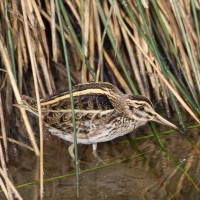Opis
The river Plym Estuary is an important area for wintering birds. It houses wintering populations of czapla nadobna, kwokacz, mewa czarnogłowa, mewa polarna, mewa blada, szablodziób, szlachar, kulik wielki and krwawodziób. But many other birds can be seen, see the birdlist below.
Szczegóły
Dostęp
The estuary is surrounded by roads and footpaths. It is easily watched and has parkland on it's eastern side. It's South side is best during sunny days, avoiding glare off exposed mud/water. The high water roost is at it's North Eastern end, for those with limited time and wanting to visit the high water roost only use Coypool Park & Ride (Free - marked with P and Star on map). If you want to walk around the entire estuary, that's a distance of 7 km. Click on the P's on the map to get directions.
Teren i siedlisko
Rzadkie drzewa i krzewy , Łąka , Tereny podmokłe , Rzeka , Morze , Błota , Miasto/wieś , LasWarunki
Płaski , Otwarty krajobraz , Możliwy wysoki poziom wodyTrasa dookoła
TakCzy luneta będzie przydatna ?
Może być przydatnaUdany sezon obserwacyjny
Przez cały rokNajlepszy czas na wizytę
Wiosenne migracje , Jesienne migracje , Jesień , Wiosna , ZimaTrasa
Droga utwardzona , Szeroka ścieżka , Wąski szlakPoziom trudności szlaku pieszego
ŁatwyDostępne
Pieszo , Rower , Samochód , Wózek inwalidzkiCzatownia/platforma obserwacyjna
TakDodatkowe informacje
Recently the National Trust who own Saltram Park have closed off access to the embankment that holds the high water roost at Blaxton Meadow (or Blaxton Marsh/, please DO NOT walk on this embankment as this has a major effect on wintering birds.
NB, Blaxton Meadow (or Marsh) is not to be confused with Blaxton Creek, which can be found on Lopwell Dam and Tavy Estuary (see separate entry).




